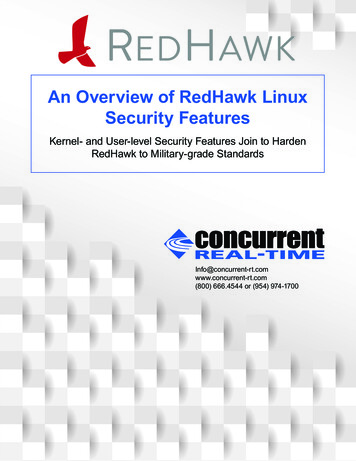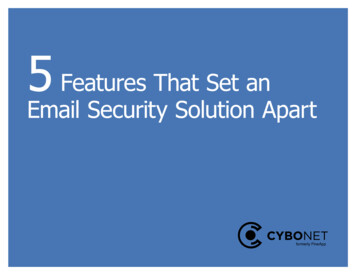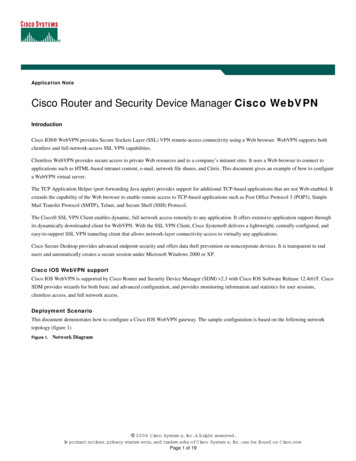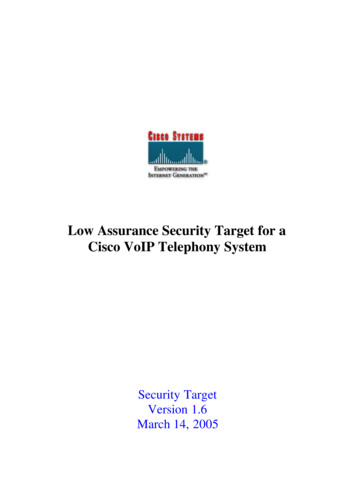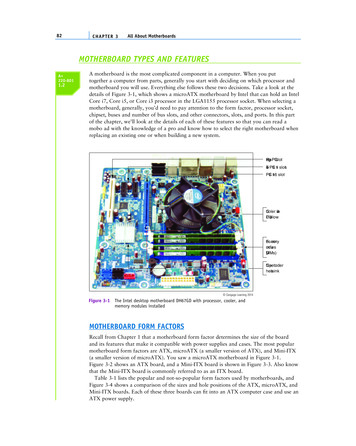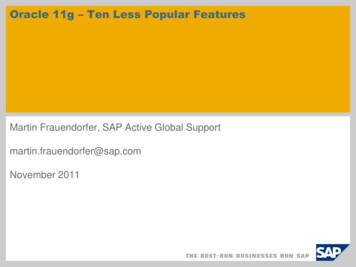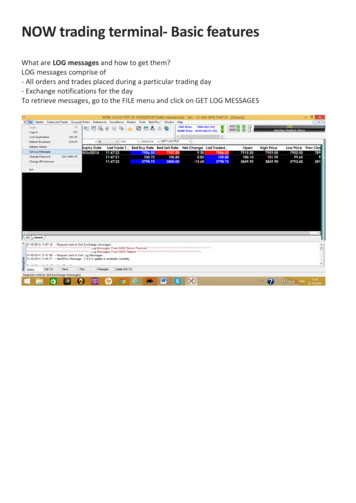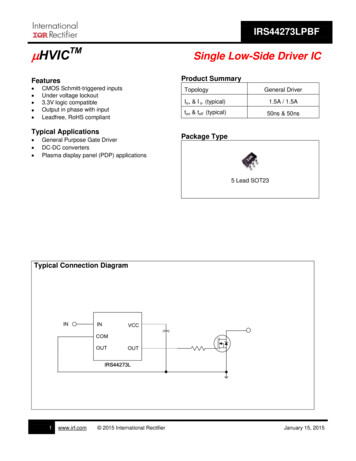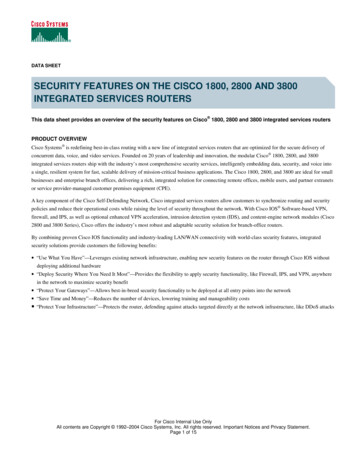
Transcription
DATA SHEETSECURITY FEATURES ON THE CISCO 1800, 2800 AND 3800INTEGRATED SERVICES ROUTERS This data sheet provides an overview of the security features on Cisco 1800, 2800 and 3800 integrated services routersPRODUCT OVERVIEWCisco Systems is redefining best-in-class routing with a new line of integrated services routers that are optimized for the secure delivery ofconcurrent data, voice, and video services. Founded on 20 years of leadership and innovation, the modular Cisco 1800, 2800, and 3800integrated services routers ship with the industry’s most comprehensive security services, intelligently embedding data, security, and voice intoa single, resilient system for fast, scalable delivery of mission-critical business applications. The Cisco 1800, 2800, and 3800 are ideal for smallbusinesses and enterprise branch offices, delivering a rich, integrated solution for connecting remote offices, mobile users, and partner extranetsor service provider-managed customer premises equipment (CPE).A key component of the Cisco Self-Defending Network, Cisco integrated services routers allow customers to synchronize routing and securitypolicies and reduce their operational costs while raising the level of security throughout the network. With Cisco IOS Software-based VPN,firewall, and IPS, as well as optional enhanced VPN acceleration, intrusion detection system (IDS), and content-engine network modules (Cisco2800 and 3800 Series), Cisco offers the industry’s most robust and adaptable security solution for branch-office routers.By combining proven Cisco IOS functionality and industry-leading LAN/WAN connectivity with world-class security features, integratedsecurity solutions provide customers the following benefits: “Use What You Have”—Leverages existing network infrastructure, enabling new security features on the router through Cisco IOS withoutdeploying additional hardware “Deploy Security Where You Need It Most”—Provides the flexibility to apply security functionality, like Firewall, IPS, and VPN, anywherein the network to maximize security benefit “Protect Your Gateways”—Allows best-in-breed security functionality to be deployed at all entry points into the network “Save Time and Money”—Reduces the number of devices, lowering training and manageability costs “Protect Your Infrastructure”—Protects the router, defending against attacks targeted directly at the network infrastructure, like DDoS attacksFor Cisco Internal Use OnlyAll contents are Copyright 1992–2004 Cisco Systems, Inc. All rights reserved. Important Notices and Privacy Statement.Page 1 of 15
CISCO SELF-DEFENDING NETWORKCisco 1800, 2800 and 3800 routers support a wide range of security features as part of the Cisco Self-Defending Network, a strategy to alloworganizations to identify, prevent, and adapt to security threats. The Cisco Self-Defending Network has four categories of protection that applyto the router: Secure connectivity—Provides secure and scalable network connectivity, incorporating multiple types of traffic. Examples include VPN,Dynamic Multipoint VPN (DMVPN), Multi-VRF and MPLS Secure Contexts, Voice and Video Enabled VPN (V3PN), and secure voice. Threat Defense—Prevents and responds to network attacks and threats using network services. Examples include Cisco Intrusion PreventionSystem (IPS) and Cisco IOS Firewall. Trust and Identity—Allows the network to intelligently protect endpoints using technologies such as Network Admission Control (NAC),Identity services and AAA. Network Infrastructure Protection—Protects the network infrastructure from attacks and vulnerabilities, especially at the network level.Examples include control-plane policing, Network-Based Application Recognition (NBAR) and AutoSecure.INTEGRATED SERVICES ROUTER FEATURESTo help enable security features on the Cisco 1800, 2800 and 3800 Series, the following Cisco IOS Software feature sets are available: Advanced Enterprise Services Advanced IP Services Advanced SecurityFor more information about selecting the appropriate feature set, rel/ps5460/prod bulletin09186a00801af451.htmlSECURE CONNECTIVITY: VPN TUNNELING AND ENCRYPTION, DMVPN, EASY VPN, V3PN AND MULTI-VRF CONTEXTSVPN Tunneling and EncryptionVPNs have been the fastest growing form of network connectivity and Cisco takes it to a new standard by embedding VPN hardware into theintegrated services routers. The Cisco 1800, 2800 and 3800 routers include built-in hardware-based encryption acceleration which offloads theIPSec (AES, 3DES and DES) encryption and VPN processes to provide increased VPN throughput with minimal impact to the router CPU. Ifadditional VPN throughput or scalability is required, optional VPN encryption advanced integration modules (AIMs) are available. The result isincreased VPN performance—up to four times faster than previous models—with lower overall router CPU usage. The optional AIM providesup to ten times the encryption performance over previous models, as well as tunnel scalability. The key features of both the built-in and AIMbased VPN accelerators include: Accelerates IPSec at speeds suitable up to multiple, full-duplex T3/E3 Accelerates hardware DES, 3DES, and AES (128, 192, and 256) encryption algorithms for all modules (both built-in and AIMs) Supports Rivest, Shamir, Aldeman (RSA) algorithm signatures and Diffie-Hellman for authentication Uses Secure Hash Algorithm 1 (SHA-1) or Message Digest Algorithm 5 (MD5) hashing algorithms for data integrity Supports Layer 3 (IPPCP) compression in hardware with the addition of the VPN encryption moduleIn addition to generic IPSec, the integrated services routers can also use an alternate tunneling technique that combines IPSec and genericrouting encapsulation (GRE) protocols. The IPSec with GRE tunneling technique is a unique Cisco solution that helps enable dynamic routingprotocols to be sent over the VPN, thus delivering greater network resiliency than IPSec-only solutions. In addition to providing a failovermechanism, GRE tunnels provide the ability to encrypt multicast and broadcast packets and non-IP protocols. By using GRE with IPSec, Ciscointegrated services routers can support protocols such as AppleTalk and Novell Internetwork Packet Exchange (IPX) as well as multicast andbroadcast applications, such as video.For Cisco Internal Use Only 2004 Cisco Systems, Inc. All right reserved.Important notices, privacy statements, and trademarks of Cisco Systems, Inc. can be found on cisco.comPage 2 of 16
Dynamic Multipoint VPN (DMVPN)Cisco leads the industry with the first routers to offer DMVPN functionality. Cisco DMVPN enables on-demand and scalable full mesh VPN toreduce latency, conserve bandwidth, and simplify VPN deployment (See Figure 1). The DMVPN feature builds upon Cisco IPSec and routingexpertise by enabling GRE tunnels, IPSec encryption, Next Hop Resolution Protocol (NHRP) , OSPF and EIGRP to be dynamically configured.This dynamic configuration of VPN tunnels, combined with technologies such as QoS and Multicast, optimizes latency-sensitive applicationslike voice and video. DMVPN also eases administrative burden with zero configuration at the hub when adding new spokes or when setting upspoke to spoke connections.Figure 1Example of DMVPNEasy VPNEasy VPN is an IPSec solution designed to support hub-and-spoke VPN topologies with minimal effort and high scalability. Easy VPNsimplifies provisioning and management of VPN solutions between PIX Firewalls, VPN 3000, and routers of all sizes. Proven in thousands ofcustomer installations, Easy VPN uses “policy-push” technology to simplify configuration while retaining feature richness and policy control.Easy VPN offers the following benefits: Easy VPN supports both hardware (access routers) CPE and software remote access clients using the same central-site router. The Cisco VPNSoftware Client can be installed on PCs, Macs, and UNIX systems to add remote access connectivity to the router-based VPN at noadditional cost. Because a single technology (Easy VPN) is used for both the hardware CPE and software clients, total cost of ownership isreduced through simplification and unification of provisioning, monitoring, and AAA services. Easy VPN offers options of locally router-based and, centralized RADIUS and AAA authentication of both CPE routers and individual users.The 802.1x authentication also can be used to authenticate hosts at each CPE location. Easy VPN offers digital certificates, improving security over pre-shared keys.For Cisco Internal Use Only 2004 Cisco Systems, Inc. All right reserved.Important notices, privacy statements, and trademarks of Cisco Systems, Inc. can be found on cisco.comPage 3 of 16
Load balancing for multiple central-site Easy VPN concentrators provides automatic distribution of load across multiple Easy VPN servers.Policy push of backup concentrator information to the CPEs allows scaling the solution without CPE reconfiguration. Virtualized Easy VPN Server allows service providers to offer multicustomer VPN services on a single platform. Easy VPN offers full-feature integration, including dynamic QoS policy assignment, firewall and IPS, split tunneling, and Service AssuranceAgent and NetFlow for performance monitoring. Cisco Security Device Manager (SDM) allows wizard-based quick deployment of Easy VPN integrated with AAA and Firewall, and real-timegraphical monitoring of remote Easy VPN Clients. Easy VPN Server Administrator has the ability to log-off remote clients. Easy VPN is supported on all Cisco VPN service product lines: Cisco IOS Software, Cisco PIX Firewall, and Cisco VPN 3000 SeriesConcentratorV3PN: Voice and Video Enabled IPSecThe Cisco 1800, 2800 and 3800 support V3PN. V3PN provides a VPN infrastructure capable of converged data, voice, and video across asecure, QoS-enabled IPSec network and allows customers to obtain the same performance for voice and video applications over an IP transportas they would over an alternate WAN link—securely and effectively. Unlike many VPN devices on the market, Cisco integrated services routersaccommodate the diverse network topology and traffic requirements that enable multiservice IPSec VPNs. The end-to-end network architectureof V3PN takes advantage of Cisco security-enabled routers with Cisco IOS Software to secure voice traffic.Delivering toll-quality voice and video over IPSec VPNs requires more than just encrypting traffic—it requires a blend of advancedmultiservice and IPSec VPN technologies. Primary Cisco IOS Software technologies that help enable Cisco V3PN include: multiservice-centricQoS; support for diverse traffic types; support for multiservice network topologies; and enhanced network failover capabilities.Multi-VRF and MPLS Secure Contexts for Service ProvidersMulti-VRF, also referred to as VRF-Lite, provides the ability to configure and maintain more than one instance of a routing and forwardingtable within the same physical router. Multi-VRF, in combination with Ethernet VLAN technologies and WAN VPN technologies such asFrame Relay, enables the provisioning of several logical services using one physical network, extending the privacy and security down to abranch office LAN.One Cisco router with Multi-VRF can support multiple organizations with overlapping IP addresses, while maintaining separation of data,routing, and physical interfaces. For more information on Multi-VRF, visit the Product Bulletin.THREAT DEFENSE: CISCO IOS FIREWALL, TRANSPARENT FIREWALL, INTRUSION PREVENTION, URL FILTERING ANDCONTENT SECURITYCisco IOS FirewallThe Cisco IOS Firewall is a stateful inspection firewall option available for Cisco routers. Leveraged from market-leading PIX firewalltechnologies, Cisco IOS firewall is supported on all the integrated services routers with the Cisco IOS Software Advanced Security or higherfeature sets. Cisco IOS Firewall is an ideal single-box security and routing solution for protecting the WAN entry point into the network. Whilethe hub is a common location to firewall and inspect traffic for attacks, it is not the only location to consider when deploying security. Branchoffices are also an important location in your network to both firewall and inspect traffic for attacks.The key features of Cisco IOS Firewall include: Stateful firewall including Denial of Service protection Enhanced application, traffic and user awareness to identify, inspect, and control applications. Advanced protocol inspection for voice, video, and other applications Per-user, interface, or sub-interface security policiesFor Cisco Internal Use Only 2004 Cisco Systems, Inc. All right reserved.Important notices, privacy statements, and trademarks of Cisco Systems, Inc. can be found on cisco.comPage 4 of 16
Tightly integrated identity services to provide per-user authentication and authorization Ease of management through features such as Role-Based Access/CLI Views which allows Secure, Logical separation of router betweenNetOps, SecOps,and End-Users and Firewall Policy View in Cisco SDM.The Cisco IOS Firewall not only helps enable a single point of protection at the perimeter of a network, it also makes security policyenforcement an inherent component of the network itself. The flexibility and cost-effectiveness of both dedicated and integrated policyenforcement facilitates security solutions for extranet and intranet perimeters and Internet connectivity for a branch or remote office. Integratedinto the network through Cisco IOS Software, the Cisco IOS Firewall also allows customers to use advanced quality-of-service (QoS) featuresin the same router.Cisco IOS supports IPv6 firewall which enables deployment in mixed IPv4 and IPv6 environments. Cisco IOS firewall IPv6 offers statefulprotocol inspection (anomaly detection) of IPv6 packets and IPv6 Denial of Service attack mitigation.Transparent FirewallIn addition to Layer 3 stateful firewalling, the Cisco 1800, 2800 and 3800 can support transparent firewalling, which is the ability to provideLayer 3 firewalling for Layer 2 connectivity. The benefits of a transparent firewall follow: Easy addition of firewall to existing networks—no IP subnet renumbering required Support for subinterfaces and VLAN trunks Spanning Tree Protocol support—handles bridge-protocol-data-unit (BPDU) packets correctly per 802.1d, not just “pass or drop” Support for mixing Layer 2 and Layer 3 firewalling on the same router No need for IP addresses on the interfaces Support for all standard management tools Support for Dynamic Host Configuration Protocol (DHCP) pass-through to assign DHCP addresses on opposite interfaces (bidirectional)Figure 3 shows an application of Transparent Firewall.Figure 2Segment Existing Network Deployments into Security Trust Zones Without Making Address Change Cisco IOS Firewall Provides Transparent Layer 2 SegmentationFor Cisco Internal Use Only 2004 Cisco Systems, Inc. All right reserved.Important notices, privacy statements, and trademarks of Cisco Systems, Inc. can be found on cisco.comPage 5 of 16
Error! Bookmark not defined.Intrusion Prevention System (IPS)Cisco leads the industry with the first routers to offer IPS functionality. Cisco IOS IPS is an in-line, deep-packet, inspection-based solution thathelps enable Cisco IOS Software to effectively mitigate network attacks. Used for intrusion prevention and event notification, the Cisco IOS IPSleverages technology from the Cisco IDS Sensor families, including Cisco IDS 4200 Series Appliances, Catalyst 6500 IDS Services Module,and Network Module hardware IDS appliances. Because Cisco IOS Software IPS is in-line, it can drop traffic, send an alarm, or reset theconnection, which enables the router to respond immediately to security threats and protect the network.While the hub is a common location to firewall and inspect traffic for attacks, it is not the only location to consider when deploying security—attacks can also originate at the branch. Through collaboration with IPSec VPN, GRE, and Cisco IOS Firewall, Cisco IOS IPS can allowdecryption, tunnel termination, firewalling, and traffic inspection at the first point of entry into the network (branch or hub)—an industry first.Cisco IOS IPS helps stop attacking traffic as close to the source as possible.Combined with the release of the Cisco 1800, 2800 and 3800 routers are several new capabilities: The ability to load and enable selected IDS signatures in the same manner as Cisco IDS Sensor Appliances An increase in the number of supported signatures to more than 700 of the signatures supported by Cisco IDS Sensor platforms The ability for a user to modify an existing signature or create a new signature to address newly discovered threats (each signature can beenabled to send an alarm, drop the packet or reset the connection)An additional capability allows users who want maximum intrusion protection to select an easy to use signature file that contains “most-likely”worm and attack signatures. Traffic matching these high confidence-rated worm and attack signatures is configured to be dropped. Cisco SDMprovides an intuitive user interface to provision these signatures, including the ability to upload new signatures from Cisco.com withoutrequiring a change in software image and configures the router appropriately for these signatures.URL Filtering (off-box/on-box optional)Cisco has URL filtering to support the Cisco IOS Firewall. This allows a customer to use either Websense or N2H2 URL filtering products withCisco security routers. The Websense URL Filtering feature helps enable your Cisco IOS Firewall to interact with the Websense or N2H2 URLfiltering software, thereby allowing you to prevent users from accessing specified Websites on the basis of your security policy. The Cisco IOSFirewall works with the Websense and N2H2 server to know whether a particular URL should be allowed or denied (blocked). Refer also to theContent Engine Network Module for URL Filtering capabilities on the Cisco 2800 for complete on-box URL filtering and content security.Advanced Security Network Modules (Cisco 2800 and 3800 Option)For customers seeking a dedicated, hardware-based solution for IDS and content security, two security network modules are available for theCisco 2800 and 3800 routers.Intrusion Detection Network ModuleWhen the Cisco IDS Network Module (part number NM-CIDS) is added to the Cisco 2800 or 3800 routers, it helps enable a complete IDSsystem as part of the Cisco IDS sensor portfolio. These IDS sensors work in concert with the other IDS components, including Cisco IDSManagement Console, the CiscoWorks VPN/Security Management Solution (VMS), and Cisco IDS Device Manager, to efficiently protect yourdata and information infrastructure. The Cisco IDS Network Module has a dedicated CPU for IDS and a 20-GB hard drive for logging withmore than 1000 IPS signatures supported. Through collaboration with IPSec VPN and GRE traffic, this module can allow decryption, tunneltermination, and traffic inspection at the first point of entry into the network—an industry first. This reduces the need for any additional devicestypically required to support the system, lowering operating and capital expenditure costs while enhancing security.For Cisco Internal Use Only 2004 Cisco Systems, Inc. All right reserved.Important notices, privacy statements, and trademarks of Cisco Systems, Inc. can be found on cisco.comPage 6 of 16
Content Security Network ModuleThe Cisco Content Engine Network Module (part number NM-CE) when combined with the Cisco 2800 or 3800 routers offers a routerintegrated content-delivery system with content security features. In addition to intelligent caching and content routing, the Cisco ContentEngine Network Module also provides URL filtering. Each content-engine network module ships with a copy of SecureComputing URLfiltering software.TRUST AND IDENTITY: NET
Cisco Security Device Manager (SDM) allows wizard-based quick deployment of Easy VPN integrated with AAA and Firewall, and real-time graphical monitoring of remote Easy VPN Clients. Easy VPN Server Administrator has the ability to log-off remote clients. Easy VPN is supported on all Cisco VPN servi

